
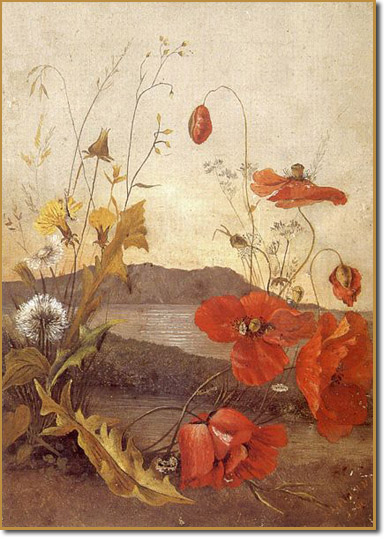 Princess Kaiulani
Princess Kaiulani
Her Life and Times
by Jennifer Fahrni
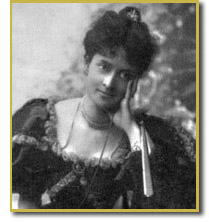 "It has been a strange life, really, and a very romantic one." - Victoria Ka'iuani Cleghorn.
"It has been a strange life, really, and a very romantic one." - Victoria Ka'iuani Cleghorn.
For the last 100 years, Princess Victoria Ka`iulani Cleghorn may have been known as tragic because she died young, and was never permitted to serve the office for which she was trained, Queen of the Hawaiian Islands. It’s difficult to know why, but for unknown reasons, the story of her heroism has been forgotten. We’ve seen her as a shy, quiet but beautiful little girl who lived a melancholy life. Few people know of Ka`iulani's stand for her people, and fewer still, know that she was a ‘daughter of a double race’, half Hawaiian – half Scottish.
Ka‘iulani was, in fact, a warrior - she fought for the truth.
While overcoming many personal tragedies, Ka‘iulani led a life of love and music. She was witty, had a sharp sense of humor, and a great many friends. There is also a possibility that Ka'iulani influenced surfing in the English Channel at Brighton. This is the real Ka'iulani that is much more interesting to remember.
There are few accounts of Ka‘iulani's fight for her nation. But we owe it to her to remember that story.
"Poppies", landscape of the Scottish countryside, oil on canvas by Victoria Ka'iulani Cleghorn, 1890. A letter written to her Father from Great Harrowden Hall, near Wellingborough, indicates that she painted this for her 'Auntie Liliu', Princess Liliuokalani.
Crown Princess Victoria Ka‘iulani is Hawaii's Most Beloved Hawaii/Scot
"Every one admired her attitude; they could not do otherwise. Her dignity, her pathetic resignation, her silent sorrow, appealed
to all. The natives loved her for her quiet steadfast sympathy with
their woe, her uncomplaining endurance of her own; the whites
admired her for her stately reserve, her queenly display of all necessary
courtesy, while holding herself aloof from all undue intimacy. All were
attracted by her sweetness and grace; it was impossible not to love her."[10]
Ka'iulani's Parents - Princess Miriam Likelike and Archibald Scott Cleghorn

Archibald Scott Cleghorn, born November 15th 1835 in Edinburgh, Scotland, was brought to Hawaii by his parents, Mr. and Mrs. Thomas Cleghorn by way of New Zealand. After arriving to Honolulu in 1851, Thomas set up a dry goods store in Chinatown, but within the year, at the age of 54, Thomas suffered a fatal heart attack while on his way home from church. Archibald took over his father's business and turned it into one of the most successful mercantile chains in the islands. Continuing his father's love of horticulture, Archie also became known as Hawaii’s Father of Parks and served as O'ahu County Parks Commissioner. He was the lead landscaper for what is the present location for the Hawaiian Scottish Festival & Highland Games, Kapi'olani Park, as well as landscaper for 'Iolani Palace. Archibald is also responsible for the spectacular gaardens of the 'Ainahau estate, where he planted several varieties of plants, shrubs and trees, including Hawaii's first banyan, which became known as 'The Ka'iulani Banyan'. A slip from this tree was planted at Princess Ka'iulani Elementary School upon Princess Ka'iulani's passing. Archibald, a great friend and advisor to King Kalakaua, was also advisor to Queen Lili'uokalani, and served as Royal Governor of Oahu in the 1890's. He also served as the first President of The Queen's Hospital, a member of the Privy Council, the Board of Health, the Board of Prison Inspectors, the Board of Immigration, and for 46 years, the president of the Pacific Club. Archibald Cleghorn willed the magnificent estate of 'Ainahau back to Hawaii, specifying that it be retained as a park for all Hawaii to enjoy. It was to be named, Ka’iulani Park in the center of Waikiki. Today, Cleghorn Street is a two block-long street located near the Princess Kaiulani Hotel.
The San Francisco Call, 1910: "CLEGHORN LEAVES HONOLULU A PARK -- Bequeaths Home Site in Memory of Princess Daughter – Ainahau, the beautiful residence and park at Waikiki, formerly the home of Governor Cleghorn, has become the property of the public, the will of the late governor, filed for probate yesterday, bequeathing the property to the public use as a park, to be known as Ka’iulani Park, after his daughter, the late Princess Ka’iulani. The Ainahau property is a very valuable one and makes an important addition to the Honolulu park system..."
___________________
Before becoming King, the empassioned and politically ambitious David Kalakaua, who led a group called the Young Hawaiians, introduced his friend Archibald Cleghorn, to his sister, Miriam Likelike. Archibald was smitten by the young beauty, and with the approval of David Kalakaua, he began courting her. Archie and Likelike Married September 22, 1870 at Washington Place, the home of Likelike's sister, Lydia and Governor John Dominis. Four years later in 1874, Likelike's brother, David Kalakaua began his reign as King of the Kingdom of Hawaii. On December 12th of that year, he was the world's first ruling monarch to be honored with a state dinner at the White House. The evening, which is the most glamorous of events at the White House, was hosted by President and Mrs. Ulysses S. Grant.
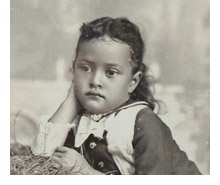 Nearly a year later on October 16, 1875 the Hawaiian nation was thrilled to learn of the birth of Archie and Likelike's daughter, Princess Victoria Ka‘iulani Kawekio I Lunalilo Kalaninuiahilapalapa Cleghorn. The city was alive with the sound of church bells ringing to celebrate her royal birth, as highest born ali'i of her generation. At the time of her birth, Ka'iulani had three older half sisters born to her father Archibald and Elizabeth Pauahi Lapeka: Rose Kaipuala Cleghorn (married James William Robertson), Helen Mani'iailehua Cleghorn (married James Boyd), and Annie Pauai Cleghorn (married James Hay Wodehouse). Family, friends and those who wished to see the baptism of high rank, attended Ka'iulani's Christening at one o'clock in the afternoon on Christmas Eve at St. Andrews Cathedral. Standing as Godparents were the King, and Her Highness Ke'elikolani. The tiny child remained calm and silent as water dripped on her forehead from the container decorated with white flowers and the enscribed words, 'Suffer the little children to come unto Me'. Following the ceremony, King Kalakaua and Queen Kapi'olani hosted an enormous and lavish party at Iolani Palace where the celebrations continued.
Nearly a year later on October 16, 1875 the Hawaiian nation was thrilled to learn of the birth of Archie and Likelike's daughter, Princess Victoria Ka‘iulani Kawekio I Lunalilo Kalaninuiahilapalapa Cleghorn. The city was alive with the sound of church bells ringing to celebrate her royal birth, as highest born ali'i of her generation. At the time of her birth, Ka'iulani had three older half sisters born to her father Archibald and Elizabeth Pauahi Lapeka: Rose Kaipuala Cleghorn (married James William Robertson), Helen Mani'iailehua Cleghorn (married James Boyd), and Annie Pauai Cleghorn (married James Hay Wodehouse). Family, friends and those who wished to see the baptism of high rank, attended Ka'iulani's Christening at one o'clock in the afternoon on Christmas Eve at St. Andrews Cathedral. Standing as Godparents were the King, and Her Highness Ke'elikolani. The tiny child remained calm and silent as water dripped on her forehead from the container decorated with white flowers and the enscribed words, 'Suffer the little children to come unto Me'. Following the ceremony, King Kalakaua and Queen Kapi'olani hosted an enormous and lavish party at Iolani Palace where the celebrations continued.
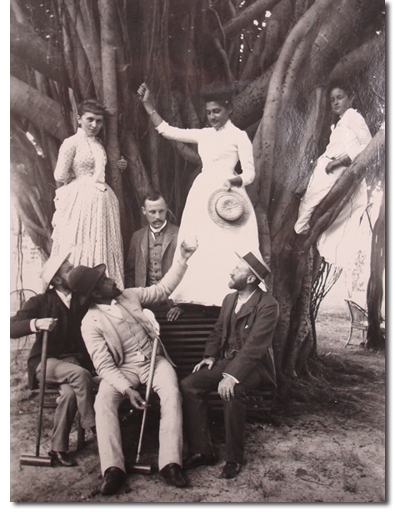 Ka`iulani spent her childhood in a paradise setting at `Âinahau (cool land) in Waikiki. 'It was a pleasant time...a gracious time, reminiscent of bygone days...a place where one could find peace, beauty and serenity.' As Princess Likelike wrote in her song of `Âinahau, "Na ka wai lûkini, Wai anuhea o ka rose, E ho`opê nei i ka liko o nâ pua, Na ka manu pîkake, Manu hulu melemele, Nâ kâhiko ia o ku`u home. - It is the perfume and the lovely fragrance of roses that sweeten the leaf buds of the flowering plants, the peacocks and the yellow feathered birds are the adornments of my home. It is the gentle breeze from the sea that brings the sweet odor of lîpoa sea weed mingling with the fragrance of my love, of my home." Ka'iulani's days were spent in games of croquet with friends, riding her pony, Fairy through the neighborhood, or creating a flowery fantasy world beneath their sheltering banyan. She would think of it often, later in life when she was away from her island home. This estate, which was also home to her treasured peacocks, was given to Ka'iulani by her godmother, Princess Ruth Ke`elikôlani. (Ruth Luka Keanolani Kauanahoahoa Ke'eelikolani), whom she called Auntie Ruth or Mama Nui. This entire estate was later willed back to Hawaii by Ka'iulani's father, Scotsman, Archibald Scott Cleghorn.
Ka`iulani spent her childhood in a paradise setting at `Âinahau (cool land) in Waikiki. 'It was a pleasant time...a gracious time, reminiscent of bygone days...a place where one could find peace, beauty and serenity.' As Princess Likelike wrote in her song of `Âinahau, "Na ka wai lûkini, Wai anuhea o ka rose, E ho`opê nei i ka liko o nâ pua, Na ka manu pîkake, Manu hulu melemele, Nâ kâhiko ia o ku`u home. - It is the perfume and the lovely fragrance of roses that sweeten the leaf buds of the flowering plants, the peacocks and the yellow feathered birds are the adornments of my home. It is the gentle breeze from the sea that brings the sweet odor of lîpoa sea weed mingling with the fragrance of my love, of my home." Ka'iulani's days were spent in games of croquet with friends, riding her pony, Fairy through the neighborhood, or creating a flowery fantasy world beneath their sheltering banyan. She would think of it often, later in life when she was away from her island home. This estate, which was also home to her treasured peacocks, was given to Ka'iulani by her godmother, Princess Ruth Ke`elikôlani. (Ruth Luka Keanolani Kauanahoahoa Ke'eelikolani), whom she called Auntie Ruth or Mama Nui. This entire estate was later willed back to Hawaii by Ka'iulani's father, Scotsman, Archibald Scott Cleghorn.
Her beloved Mama Nui was most special to Ka‘iulani. Ruth was Ka'iulani's connection to old Hawai’i. After receiving one of her many gifts from her godmother, Ka'iulani wrote this note: "Dear Mama Nui, Thank you for the nice hat you sent me. It fits so nicely Mama wanted it, but I would not let her have it. Thank you for the corn and watermelons, they do taste so good. Are you well? With much love. From your little girl, Ka‘iulani."
This was followed some time later by this letter: "Dear Mama Nui, I want another hat. Mama Likelike has taken the hat you sent me. Are you better now? When are you coming home? With much love. From your little girl, Ka‘iulani."
Ka‘iulani was an active and athletic young woman. She enjoyed horseback riding, and was an accomplished surfer and swimmer – in fact she often worried her governess by swimming dangerously far out into the breakers. Posessing the gift of the great musical Kalakaua family, Ka‘iulani also danced hula, sang and played ukulele.
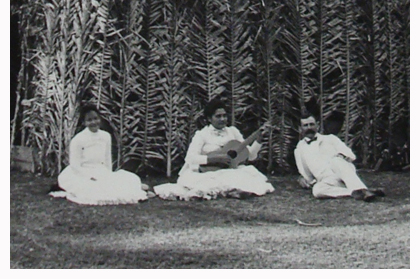 This musical dynasty often gathered at Ainahau for luaus where they would sing and try out their new musical compositions in friendly competition. When Ka‘iulani was not working on her scrapbook, she spent many hours with her best friend and half-sister Annie Cleghorn. Annie was accomplished on guitar and ukulele, so the two sisters often played music in front of the grass shack, where Ka‘iulani’s mother, Miriam Likelike composed music. Joyful times were also spent with her Uncle, King (David) Kalakaua whom she called, Papa Moi. He would tell her of the old days: "Ka‘iulani, each of us must make an agreement to... in our own ways, bring the ancient Hawaiian traditions back in a way that is pono." Among these, were the ancient Hawaiian martial arts of Lua. Kalakaua, also known as The Merrie Monarch, established a royal school to reawaken this ancient art in the late 1800's.
This musical dynasty often gathered at Ainahau for luaus where they would sing and try out their new musical compositions in friendly competition. When Ka‘iulani was not working on her scrapbook, she spent many hours with her best friend and half-sister Annie Cleghorn. Annie was accomplished on guitar and ukulele, so the two sisters often played music in front of the grass shack, where Ka‘iulani’s mother, Miriam Likelike composed music. Joyful times were also spent with her Uncle, King (David) Kalakaua whom she called, Papa Moi. He would tell her of the old days: "Ka‘iulani, each of us must make an agreement to... in our own ways, bring the ancient Hawaiian traditions back in a way that is pono." Among these, were the ancient Hawaiian martial arts of Lua. Kalakaua, also known as The Merrie Monarch, established a royal school to reawaken this ancient art in the late 1800's.
Kalakaua also taught his niece the same statement he learned at High Chief's Children's School in Honolulu. Every morning their students recited the Hawaiian Declaration of Rights of 1840. "God has made of one blood, all nations of men to dwell on the face of the earth in unity and blessedness. God has bestowed certain rights alike on all men, all chiefs, and all people of all lands." These words made a lasting impression on young Ka’iulani.
Other companions during her years in Hawaii were her governesses. First Miss Barnes, then Miss Gertrude Gardinier, and later Miss de Alcald. Ka‘iulani was very close with her teacher but at times, challenged their relationship – this could cause friction between Miss Gardinier and Princess Likelike. Ka‘iulani found out very early that she could be as naughty as she liked with her nurses and governesses and would try to escape by climbing on to the roof. Years later she admitted, "I was naturally naughty, I suppose.”
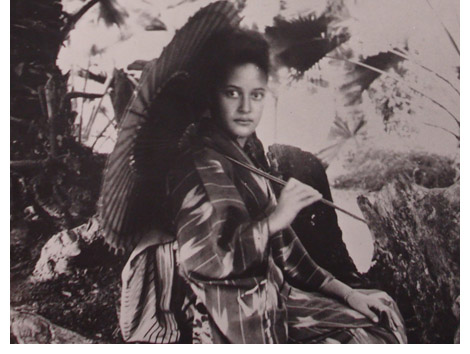 Although there was great criticism of Kalakaua's reign, particularly concerning issues of overspending, it was important for Ka‘iulani's Uncle, to bring Hawaii into the modern age. He was the first world leader to travel the globe in order to personally connect with several monarchs of other lands, which he wrote about in his composition, "Ka Momi". On his birthday (November 16) in 1886 -- Iolani Palace became the world's first royal residence to be fully lit by electricity. A year and a half later, when Ka‘iulani was 11, she threw the switch that lit up the streets of Honolulu.
Although there was great criticism of Kalakaua's reign, particularly concerning issues of overspending, it was important for Ka‘iulani's Uncle, to bring Hawaii into the modern age. He was the first world leader to travel the globe in order to personally connect with several monarchs of other lands, which he wrote about in his composition, "Ka Momi". On his birthday (November 16) in 1886 -- Iolani Palace became the world's first royal residence to be fully lit by electricity. A year and a half later, when Ka‘iulani was 11, she threw the switch that lit up the streets of Honolulu.
Just Before this however – Ka‘iulani's mother, Princess Likelike died – it was a terrible loss for her nation, and her little girl. Soon Ka'iulani was also to lose the company of her governess, Miss Gardinier, who was engaged to be married. "Feb. 2, at 5:15 o'clock, her Royal Highness Princess Miriam Likelike died in Honolulu, Hawaiian Islands, after a lingering illness of three weeks. She was born Jan. 13, 1851, consequently was a little over 36 years of age. A sister of his Majesty King Kalakaua, she was the daughter of the high chief and chiefess Kapaakea and Keohokalole." - New York Times, 1887.
Of the day her mother died, Ka‘iulani said years later, “I thought nothing would ever reconcile me to my mother’s death…. But I am glad she does not know this. I idolized my mother. She was charming; very brilliant, very happy and sunny; we worshiped each other. And I have missed her every day from the first dreadful day she died. I was taken to the palace. I remember when she lay for three weeks in state. I can see her (dead) face now laid against the cloak of feathers. Everything is black against that white, white room.”.
Honoring the musical spirit of Likelike, Ka'iulani and Annie often performed at receptions as they did for Mrs. Dewar, wife of the owner and Captain of the yacht, Nyanza in January of 1889. Annie sang a solo, "Constancy", and two duets, "The Gypsy Countess" and "Pua Hei", with their friend Miss Widemann. At the same large reception on the ship Nyanza, H. R. H. Princess Ka'iulani, Miss Cleghorn and Miss Widemann performed an ukulele trio.[1]
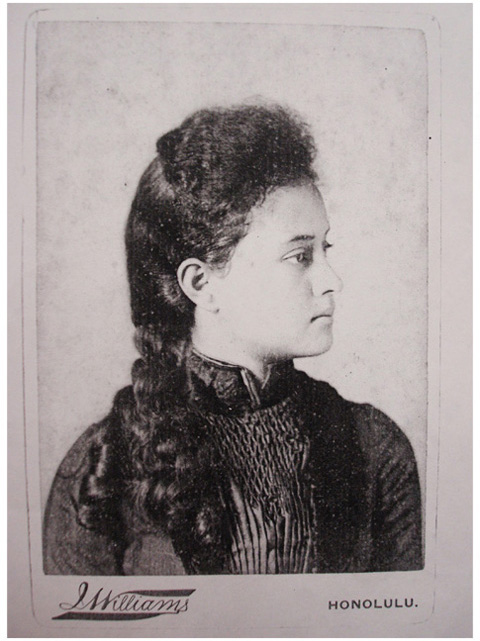
Sometime later, Honolulu would again be a happy place with the arrival of a world celebrity. Robert Louis Stevenson, the author of Treasure Island and Dr Jeckle and Mr Hyde came to visit. Hawaii greeted Stevenson with great enthusiasm, which he returned in kind.
Stevenson became good friends with her Uncle, the King as well as her father, Archibald. Archie and Louis were both born in Edinburgh, Scotland. Kalakaua had visited Scotland – the same places Ka’iulani would stay, many years later. It was an order of the King and Mr. Lorrin Thurston, a cabinet minister, that she “receive and education fit for a future queen” and to do that, she must go to England. Stevenson was able to help Ka‘iulani leave Hawaii by telling her about her father’s homeland. He told her tales of ancient Celtic queens while encouraging her curiosity of this faraway land. Stevnson's parting gift to the Princess was a beautiful poem which he wrote in her autograph book, shortly before she had to leave for England to attend school:
Forth from her land to mine she goes,
The island maid, the island rose,
Light of heart and bright of face:
The daughter of a double race.
Her islands here in southern sun
Shall mourn their Ka’iulani gone,
And I, in her dear banyan shade,
Look vainly for my little maid.
But our Scots islands far away
Shall glitter with unwanted day,
And cast for once their tempest by
To smile in Ka‘iulani's eye.
Of Ka‘iulani's three sisters, it was the youngest Annie Cleghorn, whom she was closest to. The King gave his official consent for Ka'iulani's journey to England in a letter which stated that Annie Cleghorn would accompany Ka'iulani and that they were to return one year later, in 1890. King Kalakaua also specified that Ka'iulani would travel "incognito".
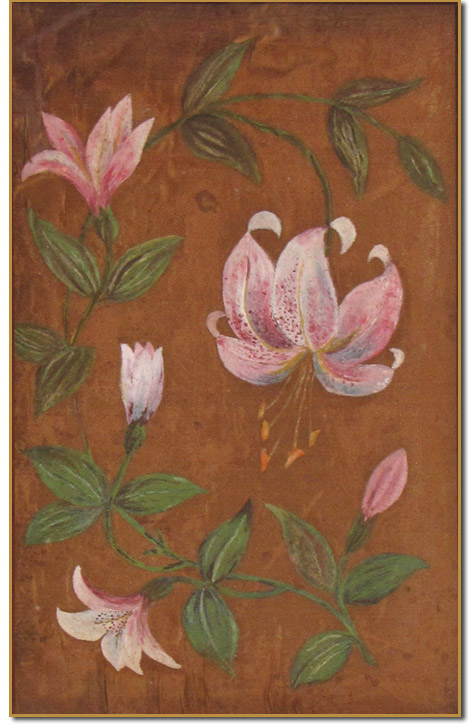 After experiencing England for the first time, in the summer of 1889, Ka'iulani felt much more a woman of the world than she had just six months earlier. She and Annie witnessed the beginning of "La Belle Epoch" in London, which inspired Ka'iulani's inner artist, and her paintings of the British countryside. Days were spent visiting art galleries, local landmarks, attending concerts and meeting celebrities of the day. This was an exciting period for the two girls, and their already strong bond, grew even closer. In September, the two girls were enrolled at Great Harrowden Hall in Northhamptonshire, England. At school, it was a challenge for Ka'iulani to get used to the bland English diet. Throughout those years, she longed for her native foods of poi, taro, and the raw fish she loved to eat.
After experiencing England for the first time, in the summer of 1889, Ka'iulani felt much more a woman of the world than she had just six months earlier. She and Annie witnessed the beginning of "La Belle Epoch" in London, which inspired Ka'iulani's inner artist, and her paintings of the British countryside. Days were spent visiting art galleries, local landmarks, attending concerts and meeting celebrities of the day. This was an exciting period for the two girls, and their already strong bond, grew even closer. In September, the two girls were enrolled at Great Harrowden Hall in Northhamptonshire, England. At school, it was a challenge for Ka'iulani to get used to the bland English diet. Throughout those years, she longed for her native foods of poi, taro, and the raw fish she loved to eat.
The girls first Christmas in England was highlighted with a visit from Ka'iulani's cousin Koa, now a handsome young gentleman of twenty-one. Both Kuhio and Koa, also attended school in England, but Kuhio was unable to join them. Ka'iulani, now a mature fourteen years old, informed Koa that, in England, she was referred to as Vike. Koa admitted he was also using his English name, David. After a year together in England, the two sisters were to be parted soon after Ka'iulani's 15th birthday. Annie was called home to Hawaii while Ka'iulani's stay was extended. The thought of leaving Ka'iulani in England was heart wrenching for Annie, and many tears were shed the day she left her little sister on the dock, to start the long journey home to Hawaii.
While remaining in Europe Ka‘iulani studied hard, traveled to different countries and raised funds for the underprivileged. Ka‘iulani was very popular in society circles and made great and lasting friendships. She also had more than a few romantic interests – but one thing was certain – when Ka‘iulani married, she would marry for love. In a letter to Queen Liliuokalani, Ka'iulani wrote: "I could have married an enormously rich German Count, but I could not care for him. I feel it would be wrong if I married a man I did not love, I should be perfectly unhappy, and we should not agree, and instead of being an example to the married women of today, I should become like one of them, merely a woman of fashion and most likely a flirt. I hope I am not expressing myself too strongly but I feel I must speak out to you and there must be perfect confidence between you and me, dear Aunt."[2]
Painting: "Lilies" oil on coconut husk painting, by Crown Princess Victoria Ka'iulani. [3]
Click here to view more Princess Ka'iulani items from the Melinda Lee Ka'iulani Cleghorn Collection.
While at school in January of 1891, Ka'iulani received the sad news of the death of her Uncle. King Kalakaua had died while on a trip to San Francisco. In a letter to Queen Kapi'olani, Ka'iulani wrote: "Dear auntie, I have only just heard the sad news from San Francisco...Auntie, you can think how I feel. I little thought when I said goodbye to my dear uncle nearly two years ago that it would be the last time I would see his dear face. Please give my love to Mama Moi and tell her I can fully sympathise with her. I cannot write anymore, but auntie, you are the only one left of my dear mother’s family so I ask you to do that little thing for me. I must close with love and kisses. I remain your loving niece, Ka‘iulani".[2]
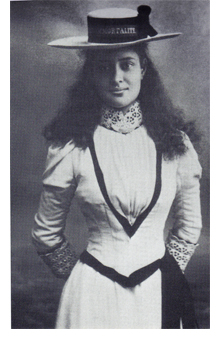 Ka‘iulani’s one year in England turned into four. Upon the succession of her Auntie Liliu to the throne, Ka'iulani was named heir to the throne by her aunt, Queen Liliuokalani. Ka'iulani admitted that although she was not in Hawaii to enjoy the celebrations, she was thrilled by the news of officially becoming "Crown Princess", an event which she had been preparing for all her life. In Hawaii, the announcement of Ka'iulani's appointment as Heir Apparent was well received by all, in fact this one event seemed to unite the native and foreign population. Back home in Honolulu, local newspapers commended her for the education she was receiving in England: "...it ought to give her the foundation of an enlightened and liberal education which will fit her for the high position which she is destined to fill."[4]
Ka‘iulani’s one year in England turned into four. Upon the succession of her Auntie Liliu to the throne, Ka'iulani was named heir to the throne by her aunt, Queen Liliuokalani. Ka'iulani admitted that although she was not in Hawaii to enjoy the celebrations, she was thrilled by the news of officially becoming "Crown Princess", an event which she had been preparing for all her life. In Hawaii, the announcement of Ka'iulani's appointment as Heir Apparent was well received by all, in fact this one event seemed to unite the native and foreign population. Back home in Honolulu, local newspapers commended her for the education she was receiving in England: "...it ought to give her the foundation of an enlightened and liberal education which will fit her for the high position which she is destined to fill."[4]
Soon, Ka'iulani was joined in England by her father, Archie, who had been eager to escort her to his native Scotland. There, the Honorable R. A. McFee hosted them at Dreghorn Castle. Ka'iulani remembered that her uncle had told her he had planted two trees at the castle. With the agreement of the McFee's she honored King Kalakaua's memory by planting another. Ka'iulani was on a mission – she made plans – she was going to be queen one day and she was preparing. Ka‘iulani learned about her Scottish roots and sought out the ancient Celtic art of her ancestors. She studied the Scots Gaelic language and made lasting bonds between the Hawaiians and the Scots. She enjoyed riding her horse at a great pace across the highlands. Ka'iulani spent many afternoons painting scenes of the Scottish countryside that she loved. One of these paintings now hangs in the Bishop Museum in Honolulu. Undoubtedly, the Scottish landscape reminded her of tropical island home. Ka‘iulani was becoming a bridge between the cultures – and the best of both.
In 1892, Ka'iulani made a new start by moving to Brighton where she was chaperoned and tutored by Mrs. Rooke who set up a curriculum including German, French and English. This village by the sea was very pleasing to the young princess and her enthusiasm was renewed.
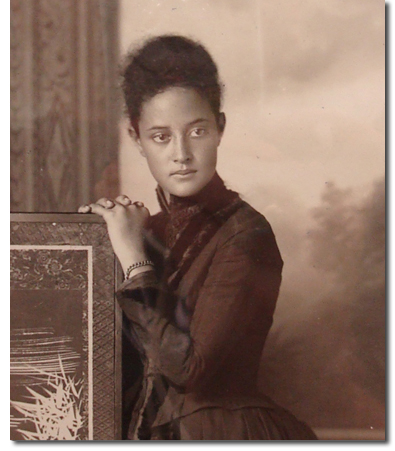 Ka‘iulani often wrote to Queen Liliu'okalani, keeping her up to date as her education progressed: "I am so glad that Father is putting up a proper house at Ainahau. It has always been my ambition to have a house at Waikiki worthy of the beautiful garden...I have left great Harrowden Hall for good. Mr. Davies has kindly found a lady who will look after and be a sort of mother to me while I am here in Brighton. I believe Ms. Rooke is a thorough lady. I shall take lessons in French, German, music and English, especially grammar and composition."[5]
Ka‘iulani often wrote to Queen Liliu'okalani, keeping her up to date as her education progressed: "I am so glad that Father is putting up a proper house at Ainahau. It has always been my ambition to have a house at Waikiki worthy of the beautiful garden...I have left great Harrowden Hall for good. Mr. Davies has kindly found a lady who will look after and be a sort of mother to me while I am here in Brighton. I believe Ms. Rooke is a thorough lady. I shall take lessons in French, German, music and English, especially grammar and composition."[5]
"I have enjoyed my studies very much during the last term and I feel that I am learning something. I can speak German quite fluently though I make a great many mistakes. I do not feel so very nervous about it as I used to. I hope Father will allow me to stay here till Christmas, then let me travel about on the continent for a month or two before I come "out" in Society.
I am looking forward to my return next year. I am beginning to feel very homesick. I shall be so very glad to see you. I suppose that you will not know me again as I have changed so much. I must close now, with very much love and kisses -- I remain, Your loving niece -- Victoria Kaiulani" [6]
One day, Ka‘iulani’s life was changed forever. She received shocking news from her guardian in England, Mr. Theophilus Davies. While in Liverpool, Davies was notified of the upheaval in Hawaii, then he received a telegram with instructions: Monarchy Abrogated - Queen Deposed - Break news to Princess.
In excerpts from a letter to Ka'iulani, Theo Davies, broke the news. The following letter was recently discovered by archivists at The Bishop Museum:
"My Dear Kaiulani, I received the news from Honolulu last night, and our first thought by the fire-side was of you. You will feel, as I did, rather bewildered at first, but the clear plain truth is that the Queen appointed a new cabinet – S. Parker, Cornwell, Colburn & Peterson, and then tried to give a new Constitution. The Ministers refused to sign it, and the Queen insisted, and then addressed the natives from the Palace steps. – The citizens then assembled and dethroned the Queen, who left the Palace – and the government is now in the hands of a Council – Mr. Dole president and Minister of Foreign Affairs... – A. C. Wilder, Thurston, Marsden, C. Carter, Castle are the deputation gone to Washington, where they will arrive on Friday next. – I had a telegram from Honolulu to-day asking me to tell you....As to you, my dear girl, you are in the hands of the loving Saviour, who makes no mistakes, and has his own plans for you. It may be that he will show you the way clearly, very soon, or he may want you to learn patience before the gift comes. We did pray for you last night and will pray for you."[7]
Ka‘iulani was shattered. It’s hard to imagine how she may have felt; perhaps if you recall your worst moment – your greatest loss, and then times that by 10 or 20 or 30. Ka`iulani was far from home and life as she knew it was being taken away for her, her family and her entire nation. She may have thought that her life’s purpose, all of her plans, all of her work, all of her education was now pointless. Lies were being printed about the Hawaiian people and who they were. These articles were printed in newspapers across the United States. Hawaiians were being called barbarians… uncivilized... unable to rule themselves. There were degrading political cartoons about both Ka'iulani and the Queen. One Minnesota newspaper cartoon portrayed Liliuokalani as a black slave, floosie attempting to hand over the Hawaiian crown to a pawnbroker for cash, while another magazine cover portrayed Hawaii as a troublemaking Topsy, the character from "Uncle Tom's Cabin.[8] It was clear that the Americans were receiving incorrect information about the Hawaii situation and that the creators of these cartoons had no direct knowledge of the Queen nor the Princess.
Lorrin Thurston's statement to the Chicago press on his way to Washington, Feb. 2, 1893 - "The great trouble was that the queen did not wish to resign constitutionally, but sided with that element whose cry had for years, 'Hawaii for the Hawaiians.' The Americans and Europeans, who have by far 'The Largest Interests' there, are not willing to let the natives spend the money which they have labored so hard to make." - confirms that 'the largest interest' was a matter of financial interest. Many Americans and Europeans had accumulated much wealth by cultivating Hawaiian soil, and much more was to be made, if the Hawaiian throne was abolished and Hawaii became an annex of the United States.
Ka'iulani's guardian in England, Theophilus Davies urged her to speak to press, however she didn’t have much faith that she could make a difference. Why would they believe to a seventeen year old girl, if they didn't believe the Queen? Ka'iulani suffered with the knowledge that the world saw her as someone quite contrary to who she was. Ka'iulani had to practice patience, while knowing that there were those who spread untruths about her intentions, her education and her character. She questioned if America had any desire to learn the truth.
In her nation's darkest hour, Ka‘iulani found the strength to make a statement to the press in England, which was printed in several newspapers including The Daily Bulletin on March 2, 1893, in Honolulu. It was her the first step in setting the record straight.
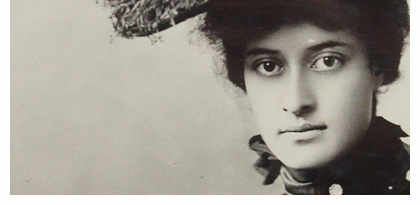 "Four years ago, at the request of Mr. Thurston, then a Hawaiian Cabinet Minister, I was sent away to England to be educated privately and fitted to the position which by the constitution of Hawaii I was to inherit. For all these years, I have patiently and in exile striven to fit myself for my return this year to my native country.
"Four years ago, at the request of Mr. Thurston, then a Hawaiian Cabinet Minister, I was sent away to England to be educated privately and fitted to the position which by the constitution of Hawaii I was to inherit. For all these years, I have patiently and in exile striven to fit myself for my return this year to my native country.
I am now told that Mr. Thurston will be in Washington asking you to take away my flag and my throne. No one tells me even this officially. Have I done anything wrong that this wrong should ‘be done to me and my people? I am coming to Washington to plead for my throne, my nation and my flag. Will not the great American people hear me?"
On February 22nd, 1893, Ka‘iulani boarded a ship for America. She was accompanied by Mr. and Mrs. Theo Davies and their daughter, Alice. Before her departure, a London reporter asked if she would be returning. She stated, "Yes, if I am successsful. I will be of age next year, and then I will carry out my original intention, ... which was to visit Queen Victoria, then visit the President of the United States, then proceed to Hawaii and assume the position to which I am entitled..." Ka'iulani expressed the hope that she might gain the sympathy of the American people. She could not see why she should be summarily deprived of her rights through no fault of her own, and without being even notified to appear in defense of them. The princess knew nothing of the affair except what she had read in the newspapers.. "I want to do all I can for my people, and be an honest, true leader to them. I simply want to do my duty to beloved Hawaii." The article which was a special to the Sacremento Record-Union stated, "The Princess shook hands warmly with the correspondent, thanked him for the sympathy shown with her cause, and asked him to convey her thanks to the American press for the hearing given her."[9]
The London press began to forward reports of the Princess to America. On February 23, 1893, The Call Newspaper in San Francisco reported "Princess Kaiulani is tall and slender, with a more thoughtful and deliberate air than might be expected in a schoolgirl." There were also newspaper reports that an uncle, John Cleghorn of San Francisco was also quickly on his way to Washington to plead the case for his niece. According to several US newspapers on Feb. 3, 1893, including the New York Times and the Salt Lake Herald, John Cleghorn stated, "If the United States will not see the justice and right of the claims I will lay before it, I shall go to England and appeal to Great Britain. Princess Kaiulani is strong brained woman capable of ruling Hawaii. She is receiving the best of education with the expectation of someday sitting on the Hawaii throne." Mr Cleghorn is extremely anxious to reach Washington to correct what he says are false impressions received by the president and cabinet. He said the princess and queen are the best of friends and the queen telegraphed her niece giving an account of the events which took her from the throne."
When Ka'iulani arrived at New York harbor, several newspapers across the United States and Hawaii, published Ka'iulani's statement to the American people: "Unbidden, stand upon your shores today where I thought so soon to receive a royal welcome on my way to my own kingdom. I come unattended, except by the loving hearts that have come with me over the wintry seas. I hear that commissioners from my land have been for many days asking this great nation to take away my little vineyard. They speak no word to me, and leave me to find out as I can from the rumors of the air that they would leave me without a home, or a name, or a nation.
Seventy years ago Christian America sent over Christian men and women to give religion and civilization to Hawaii. They gave us the gospel, they made us a nation and we learned to love and trust America. Today three of the sons of those missionaries are at your capital asking you to undo their fathers' work. Who sent them? Who gave them authority to break the constitution, which they swore they would uphold.
Today, I, a poor, weak girl, with not one of my people near me, and all these Hawaiian statesmen against me, have strength to stand up for the rights of my people. Even now I can hear their wail in my heart and it gives me strength and courage and I am strong, strong in the faith of God, strong in the knowledge that I am right, strong in the strength of 70,000,000 people who in this free land will hear my cry and will refuse to let their flag cover dishonor to mine." [10][11]
Americans, who had been reading the newspaper reports prior to Ka'iulani's statement from England were expecting a savage barbarian. With Ka'iulani's personal arrival in America however, the American press quickly began to correct their previous statements: "The Princess is 18 years old. She is a tall, beautiful young woman, with a sweet face and slender figure: She has the soft brown eyes and dark complexion that mark the Hawaiian beauty. She had come to the United States, she said, more for the purpose of learning and observing for herself the nature of the people who had been asked to take control of her country than to make a formal petition for her crown. "That," she said, "is rightfully mine, and if the Americans are the nobleminded people I think they are they will not be a party to the outrage by which I have lost my birthright"."
John Cleghorn did not accomplish what he had hoped, however, Ka‘iulani’s presence in the US forced the American press eat their words. They recorded her every move, from the moment she set foot on American soil.
Reports of Ka'iulani's speech quickly reached The White House. President Grover Cleveland and his wife First Lady Frances Cleveland were impressed, and wanted to meet this “Woman of the Hour”. Upon reading the reports of this accomplished, Crown Princess, who was being educated in England in preparation to inherit the throne of Hawaii, Cleveland believed it was possible that he been misinformed about the state of affairs in Hawaii.
"Her beauty, grace and sweetness completely won Mrs. Cleveland's heart, the President was charmed with her—how could it be otherwise? And Mr. Davies’ representations put matters before President Cleveland in a new light. He (President Cleveland) became aware of abuses which he had not suspected; he promised to do all he could in the interests of Princess Kaiulani, and he was as good as his word."[13]
In her darkest moments, Ka'iulani found the inner strength to fight for her nation in its hour of need. In the face of widespread slander and libel against the Hawaiian people and its Monarchy, she faced the world and spoke the truth. Her frank words and stunning beauty took the American President, people, and press, by storm, changing forever their idea of the Hawaiian people. Her mission to America was a triumph.
She was only seventeen at the time.
Ka'iulani's presence influenced President Cleveland to reassess the situation in Hawaii. In Washington – annexation was stopped and Minister James Blount was sent to Honolulu to conduct an in depth investigation of the political activities in Hawaii, and assess the situation. Honolulu celebrated. Colorful banners and images of Ka‘iulani decorated shop windows, celebrating their young princess.
Before her return to England on the ship Majestic, Ka'iulani wrote a farewell letter to the American people: "Before I leave this land I want to thank all those whose kindness has made my visit such a happy one. Not only the hundreds of hands I have clasped, or the smiles I have seen, but the written words of sympathy that have been sent to me from so many happy homes, have made me feel that, whatever happens to me, I shall never be a stranger to you again."[12] On the same day, it was announced that Minister Blount and and his party boarded the ship, Rush in New York which set them on their voyage to Honolulu.
Several newspaper articles described Ka'iulani as "entirely English" because of her time spent in England and the fact that the majority of her education was received there. Because of this, it was generally believed that England would support her claim to the Hawaiian throne over the challenge of the American politicians and businessmen. Although much of Ka'iulani's education was English, four years later, after Ka‘iulani returned home to Hawaii, she would say, "I am all Hawaiian. I love this country of mine. It’s sky, it’s trees, it’s people, it’s food – a longing which never passed away. When I came home at last from England, I ran about like a mad thing... I asked for all native things – poi, taro, even the raw fish we eat. You would think that a girl educated in England would shrink from that at least. My Aunt, the Queen, was delighted. She said, “That’s right. You are a good Hawaiian."
In 1897, Ka'iulani's heart was broken once again with the news of the death of her dear sister, Annie. Annie, a young mother at the time, passed away at the age of 29.
On February 12, 1898, The New York Times published an article titled, "Princess Kaiulani Engaged - To Wed Prince David Kawananakoa of Hawaiian Royal Blood. The engagement is announced of a marriage that has ben arranged between Prince David Kawananakoa and Princess Kaiulani. The formal betrothal merely awaits the signature to certain deeds of family settlement of dowager Queen Kapiolani." Throughout her years, there had been several other reports of "engagements" to various gentlemen, however, Ka'iulani's previous statement that she 'would ony marry for love', casts doubt on a number of those.
In the same year, after Hawaii was finally annexed, Ka'iulani spoke of the Annexation Ball during an interview with a SanFrancisco Call reporter, "I was asked if I would be at the Annexation Ball. I looked do you see? - looked at the one who asked me that. Then 1 said, 'Why don't you ask me if I am going to pull down Hawaii's flag for them?' You know they wanted to find twelve native girls to raise the new flag. They thought it would be poetic. They did not find them."
During a moment of reflection, Ka'iulani said, "I thought my heart would break when I heard that the monarchy was overthrown, and I had all a girl's disappointment, and I think all a Queen's. I had wanted to be a good Queen some day. I had thought about it and made all sorts of vows and plans you can think of. I dreamed of all that I would do for my people. I was sure that I could make them the happiest people in the world. They are a happy people, you know—very kind and simple and trusting. They have shown that to the world, haven't they?"
March 6th, 1899 marked the end of an era; Hawaii's most beloved Hawaii/Scot, Princess Victoria Ka'iulani Cleghorn passed away. It was an unexpected shock for the entire Hawaiian nation, both native and foreign. Some described her as weak, but Ka'iulani had been a strong young woman who loved the outdoors, where she rode on horseback, surfed, paddled and sometimes swam out beyond the breakers. Although she became ill after encountering a storm at Waimea on the Island of Hawaii, no one thought it would lead to her death. It is likely that the stress Ka'iulani experienced throughout her life, was ultimately responsible for the onset of her illnesses.
The New York Times read: "Princess Ka’iulani died March 6 of inflammatory rheumatism contracted several weeks ago while of a visit to the Island of Hawaii. The funeral of the Princess will occur on Sunday, March 12, from the old native church, and will be under the direction of the Government. The ceremonies will be on a scale befitting the rank of the young Princess. The body is lying in state at Ainahau, the Princess’s old home. Thousands of persons, both native and white, have gone out to the place, and the whole town is in mourning. Flags on the Government buildings are at half mast, as are those on the residences of the foreign Consuls..." The old native church, the Times refers to is Kawaiaha'o Church in Honolulu.
Concerning Ka'iulani's weak heart, family friend Colonel MacFarlane noted, "The heart weakness, was the result of shock; the direct consequence of the blow that struck the young girl of scarce 19 when a cablegram announced that her promised kingdom had been wrenched away from her. It was utterly unanticipated, and she never got over it. Till then she had taken little notice of the politics of the hour; all her energies had been concentrated on study, on qualifying for the queenly role she was to assume upon her aunt's demise. She aspired to be a model queen, with modern ideas; to rule her people for their happiness, welfare and progress; to convert her small kingdon into a worthy sister of the more advanced kingdome of our day. Her whole life had been devoted to this."[13]
Death did not come easily to Ka'iulani. She fought it till the end.
More than one hundred years after her passing, Ka'iulani's voice is finding new ears. In a time when many Hawaiians are finding the need to speak out in order to preserve to their culture, her message, 'to tell your tuth', has more resonance than ever. Over the past few years, articles in newpapers and magazine have been printed in several countries. Her story has recently been told in a feature film, with others still in the planning stages. Perhaps Ka'iulani was simply ahead of her time.
Lahaina News, October 14, 2010 - "In addition to staging an authentic Hawaiian event, Fahrni is passionate about telling the story of Princess Ka‘iulani, who, in the wake of the overthrow of the Hawaiian monarchy in 1893, led a movement to reinstate the kingdom... “Ka‘iulani is a great role model for young folks today. She understood the value of her education, artistic endeavors, her friendships and understanding her roots. She was a modern thinker,” she said. “The reason I continue to tell Ka‘iulani’s story is to give the young people of today — and us old people for that matter — an example of someone who, by simply standing strong and telling the truth, changed history.
"She didn’t fail. If she hadn’t spoken up, then maybe you could say she had failed. But in the face of the worst untruths about herself and her family, when all seemed lost, Ka‘iulani, with the greatest dignity, spoke up and simply set the record straight. Her words are still strong today, and people are listening,” she concluded." - From the article, 'Be part of history at the Lahaina Royal Ho‘ike' by Mark Vieth, Editor.
A primary goal of The Ka'iulani Project is to bring the story of Ka'iulani's life to the stage and screen, in the production
"Ka'iulani - The Island Rose".
___________________
Thirty-seven years after the death of Ka'iulani, Alice Warner, the daughter of her guardian in England, Theopilus Davies, was asked to write about her childhood friend:
"My first recollection of Ka'iulani is at a children's party at Ainahau, where we were all photographed holding hands around the big banyan tree. I also vaguely remember her coming to play with us at Craigside, before we left Honolulu as a family and settled in England. After a gap of several years Kaiulani came to us at Southport, Lancashire where we then lived and she was under my Father’s guardianship while she was in England spending many of her holidays with us – She was then at school in Northamptonshire I believe.
Later she & I were together in Brighton where we studied music & literaure etc. staying with a Miss Rooke, whose house in Jersey W? Cleghorn subsequently rented. Where we had both left school we spent a winter together in Weisbaden in charge of a German lady Freulein Stoll, where interspersed with our studies we had a little gaity & a great deal of fun – as a girl of seventeen or eighteen Kaiulani was most attractive, and had many admirers-
She had a graceful figure, queenly carriage & wonderful dark eyes & a charming smile.
She could be all smiles one minute & quickly changing to frowns if she was crossed, but the smiles soon came back & she was never out of temper for long.
She was most affectionate & most generous to those she loved & though she had a very quick temper she had a sweet disposition & was always sorry for it when she lost her temper. And was anxious to make amends.
My last recollection of her was when my Father took her to Washington. My Mother & I accompanied them. I do not remember the year, but we were received privately at the White House by the President & Mrs. Cleveland and during the fortnight or so that we were in the Unites States, in Washington, New York & Boston, we were overwhelmed with kindness & hospitality.
Of her time in Jersey I know very little. I was going to visit her there, but something prevented it. I never went.
Then came her return to the Islands & the tragedy of her early death."
Alice Warner, daughter of the late Theo H. Davies of Honolulu. [14]
___________________
Facts and references continue to be added to this page.
Photos and letters not noted below in"References", are courtesy of Hawaii State Archives at Iolani Palace.
References
1. The Yacht Nyanza, The Hawaiian Gazette, (Jan., 1889) U. S. Library of Congress Archive.
2. Princess Victoria Kaiulani (June 22, 1894) letter. Daughters of Hawaii Archives. Ka'iulani's letters. Kaiulani to Liliuokalani 147-28.
3. Img. Painting, "Lilies", oil on cuconut husk by Victoria Kaiulani Cleghorn. Courtesy of Melinda Lee Ka'iulani Cleghorn Collection.
4. Not Yet Annexed, Honolulu Daily Bulletin, (March 2, 1893) U. S. Library of Congress Archive.
5. Princess Victoria Kaiulani (Feb. 5, 1892) letter. Daughters of Hawaii Archives. Ka'iulani's letters. Kaiulani to Liliuokalani 147 - 19.
6. Princess Victoria Kaiulani (Apr.19, 1892) letter. Daughters of Hawaii Archives. Ka'iulani's letters. Kaiulani to Liliuokalani 147-25.
7. Theophilus H. Davies (Jan. 30, 1893) letter. Bishop Museum Archives. Manuscript/Typescript no.: MS Group 239.1 Box 5.
8. Uncle Sam's Cabin, Art Collection GIP Political Cartoons, Bishop Museum Archives, CP 103874
9. Her Only Plaint, Kaiulani Wants but her Crown, The Sunday Call (Mar. 2, 1893). U. S. Library of Congress Archive.
10. Sacremento Record-Union, (Mar. 2, 1893). U. S. Library of Congress Archive.
11. Princess Kaiulani, the Neice of Queen Liliuokalani Arrives in New York, The Evening Bulletin, Maysville KY. (Mar. 2, 1893). U. S. Library of Congress Archive.
12. Bidding Us Goodby, The Evening Bulletin (Mar. 21, 1893). U.S. Library of Congress Archive..
13. The Princess Died of a Broken Heart,by A.R. Rose Saley,The Sunday Call (Apr. 9, 1899). U. S. Library of Congress Archive.
14. Alice Warner (Aug. 15, 1937) letter. Daughters of Hawaii Archives. Kaiulani's letters. 147-13. Note: In Hawaii, the Davies family lived at "Craigside" in Nuuanu, Oahu. In England, the family lived at "Sundown" in Hesketh Park, Southport, England.
Research for this project includes information from numerous archival newspaper articles, personal letters of the Royal Family, as well as documents from The Bishop Museum Archives, Daughters of Hawaii Archives, The Hawaiian Historical Society Archives, Hawaii State Archives at Iolani Palace, The Hawaiian Collection at UH Manoa Library and the U. S. Library of Congress Archive.
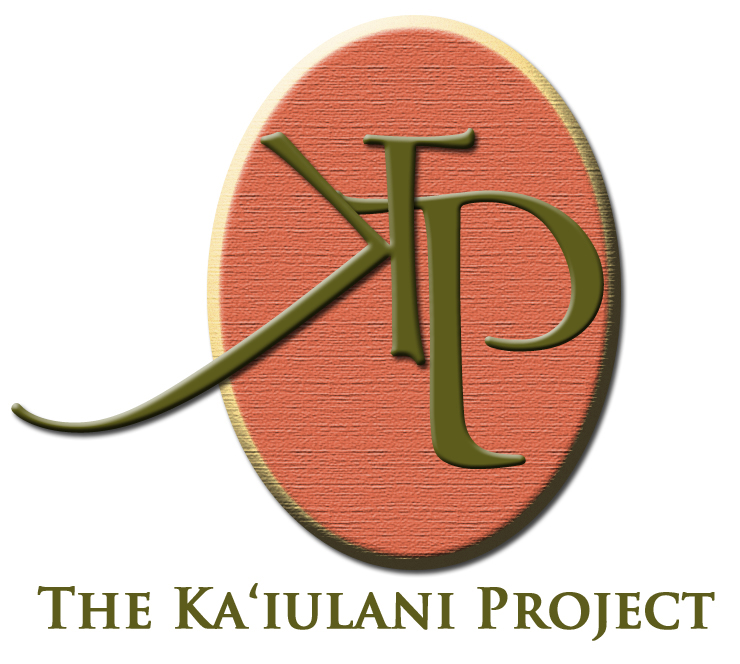
Contact
information. jjfahrni@shaw.ca
Hawaii phone.808.264.5190, mail. PO Box 1323, Lahaina,
Hawaii 96767-1323
Canada phone.604.224.6200 or 604.922.4655, mail. 4686
West 2nd Avenue, Vancouver, BC V6R1L1 Canada
All material on this site is Copyright © 2006, 2007, 2008, 2009 by Jennifer J. Fahrni and The Ka'iulani Project unless otherwise noted. All rights reserved.
The Ka'iulani website is proudly designed by C. Siobhan Halstead at Shoobee Designs